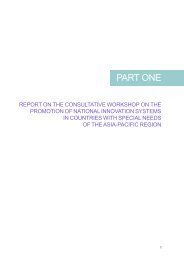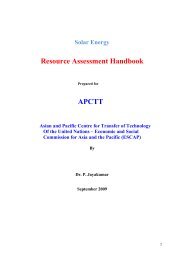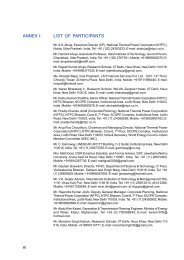Download Complete PDF - apctt
Download Complete PDF - apctt
Download Complete PDF - apctt
- No tags were found...
Create successful ePaper yourself
Turn your PDF publications into a flip-book with our unique Google optimized e-Paper software.
3. Bio-energyBio-energy, widely available in both rural and urban sectors, can be an attractive sourcefor electricity and heat. It has multiple variants – solid, liquid and gas – convertible toheat. In India, bio-energy is estimated to have 25,000 MW potential. Biomass powerplants account for about 1,000 MW of existing capacity. Bio-energy attracts annualinvestments of over US$40 billion, generates more than 7 billion units of electricity andcreates employment opportunities of more than 15 million work days in rural areas.Municipal solid waste (MSW), agro wastes, animal dung, forest residue, urban sewerage,bagasse, biomass and biofuels (from algae, jatropha, etc.) are some of the raw bioenergysources to be exploited. ‘Waste to Watts’ is a popular slogan that combineswaste management with power generation. Biothermal and biochemical processesare used to convert bio-energy sources to useable gas or liquid. Grid-connected systemsof unit sizes of 1 MW and above can be installed. India has the capacity and expertisefor producing the required equipment. Security of supply with price stability is crucial.Co-firing of coal-fed boilers with biomass is an option to save coal. Bagasse in sugarmills is a major source of co-generation. In view of multiple variants of bio-energy, thereare many inter-related issues to be studied. Conflicting interests of food versus energycall for judicious actions. Social forestry ‘tree to electricity’ scheme is an exciting areato be explored. Techno-economic and socially viable sources must be identified thatmay vary with local conditions. Standardization of technology and energy conversionequipment for bio-energy should be addressed.4. Solar energyIndia launched the Jawaharlal Nehru National Solar Mission in January 2010 for thedevelopment and deployment of solar energy technologies in the country. The Missionhas targeted 20,000 MW of solar power capacity (both thermal and PV) by 2022, withthe current (as of July 2011) installed capacity being 45 MW. The phased implementationhas targeted 1,000 MW by 2013. Cost and efficiency are issues that have limited thewidespread use of solar energy systems for both grid-connected and off-grid systems.Solar PV and solar thermal are the two routes. The cost of solar cells is claimed to befalling to a level of less than US$1/W. There are many technological challenges foreffective utilization of solar energy. The need for import of technology and equipment isa key concern for India, as it affects the energy security of the country. IndigenousR&D, coupled with local manufacture, is the way forward. Present penetration of solarenergy into the grid is negligible. Deployable technologies for PV panels and convertersystems to interface with the grid should be critically studied. Developing a solarenergizeddirect current (DC) micro-grid is an attractive option that eliminates invertersand alternating current (AC) grid interface problems if loads can be modified to work onDC supply.B. Off-grid renewable energy systemsTechnology requirements of grid-connected and off-grid systems using renewable energyare very different. The objective of off-grid systems is to provide quality power (constantvoltage, steady frequency, balanced and harmonics-free) to the consumer at varyingloads using available local energy sources. Each source will have distinct features onthe type of power it provides. A bio-energy-driven, governor-controlled engine will providevarying power to the load as per demand by adjusting the input fuel to the engine. It is45







